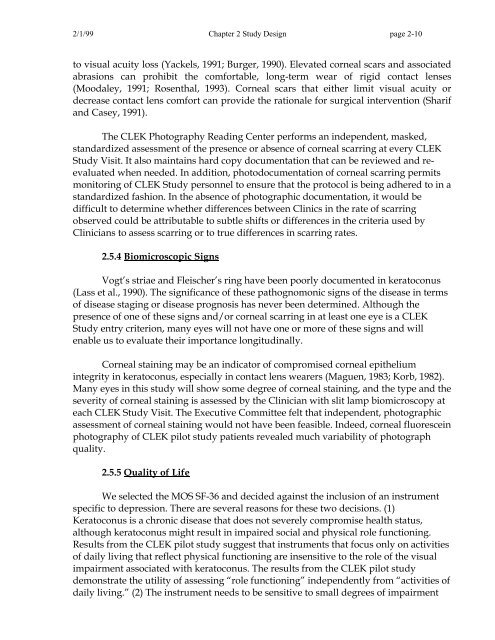OM t of c.iii - Vision Research Coordinating Center - Washington ...
OM t of c.iii - Vision Research Coordinating Center - Washington ...
OM t of c.iii - Vision Research Coordinating Center - Washington ...
You also want an ePaper? Increase the reach of your titles
YUMPU automatically turns print PDFs into web optimized ePapers that Google loves.
2/1/99 Chapter 2 Study Design page 2-10<br />
to visual acuity loss (Yackels, 1991; Burger, 1990). Elevated corneal scars and associated<br />
abrasions can prohibit the comfortable, long-term wear <strong>of</strong> rigid contact lenses<br />
(Moodaley, 1991; Rosenthal, 1993). Corneal scars that either limit visual acuity or<br />
decrease contact lens comfort can provide the rationale for surgical intervention (Sharif<br />
and Casey, 1991).<br />
The CLEK Photography Reading <strong>Center</strong> performs an independent, masked,<br />
standardized assessment <strong>of</strong> the presence or absence <strong>of</strong> corneal scarring at every CLEK<br />
Study Visit. It also maintains hard copy documentation that can be reviewed and reevaluated<br />
when needed. In addition, photodocumentation <strong>of</strong> corneal scarring permits<br />
monitoring <strong>of</strong> CLEK Study personnel to ensure that the protocol is being adhered to in a<br />
standardized fashion. In the absence <strong>of</strong> photographic documentation, it would be<br />
difficult to determine whether differences between Clinics in the rate <strong>of</strong> scarring<br />
observed could be attributable to subtle shifts or differences in the criteria used by<br />
Clinicians to assess scarring or to true differences in scarring rates.<br />
2.5.4 Biomicroscopic Signs<br />
Vogt’s striae and Fleischer’s ring have been poorly documented in keratoconus<br />
(Lass et al., 1990). The significance <strong>of</strong> these pathognomonic signs <strong>of</strong> the disease in terms<br />
<strong>of</strong> disease staging or disease prognosis has never been determined. Although the<br />
presence <strong>of</strong> one <strong>of</strong> these signs and/or corneal scarring in at least one eye is a CLEK<br />
Study entry criterion, many eyes will not have one or more <strong>of</strong> these signs and will<br />
enable us to evaluate their importance longitudinally.<br />
Corneal staining may be an indicator <strong>of</strong> compromised corneal epithelium<br />
integrity in keratoconus, especially in contact lens wearers (Maguen, 1983; Korb, 1982).<br />
Many eyes in this study will show some degree <strong>of</strong> corneal staining, and the type and the<br />
severity <strong>of</strong> corneal staining is assessed by the Clinician with slit lamp biomicroscopy at<br />
each CLEK Study Visit. The Executive Committee felt that independent, photographic<br />
assessment <strong>of</strong> corneal staining would not have been feasible. Indeed, corneal fluorescein<br />
photography <strong>of</strong> CLEK pilot study patients revealed much variability <strong>of</strong> photograph<br />
quality.<br />
2.5.5 Quality <strong>of</strong> Life<br />
We selected the MOS SF-36 and decided against the inclusion <strong>of</strong> an instrument<br />
specific to depression. There are several reasons for these two decisions. (1)<br />
Keratoconus is a chronic disease that does not severely compromise health status,<br />
although keratoconus might result in impaired social and physical role functioning.<br />
Results from the CLEK pilot study suggest that instruments that focus only on activities<br />
<strong>of</strong> daily living that reflect physical functioning are insensitive to the role <strong>of</strong> the visual<br />
impairment associated with keratoconus. The results from the CLEK pilot study<br />
demonstrate the utility <strong>of</strong> assessing “role functioning” independently from “activities <strong>of</strong><br />
daily living.” (2) The instrument needs to be sensitive to small degrees <strong>of</strong> impairment
















